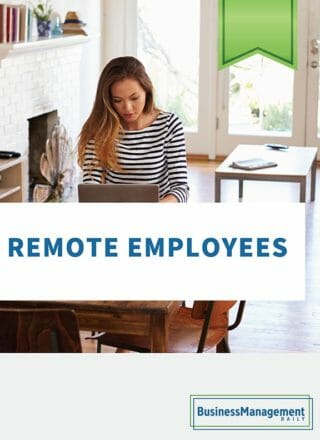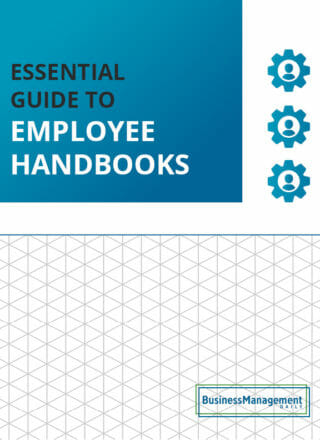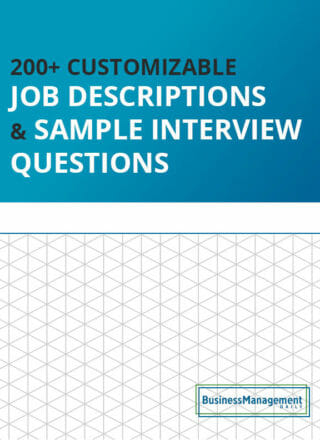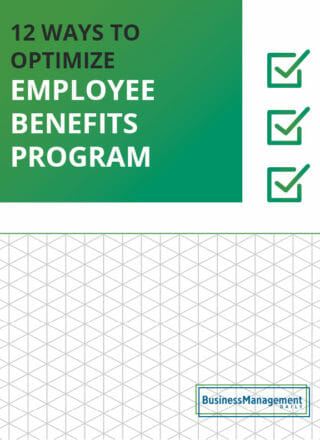Employee handbooks: The essential people management tool
Protect your business with a well-drafted employee handbook
A good employee handbook is essential for effective people management and litigation prevention. Without one, employees don’t know where to turn for basic information on your company policies. You may think operating without a handbook gives your organization flexibility. Nothing could be further from the truth.
Or perhaps your CEO wants to maintain an open-door policy and doesn’t want to be tied to written rules. It’s your job to persuade her that a well-drafted employee manual actually creates flexibility and paradoxically fosters an open-door atmosphere.
Don’t rely solely on an employee handbook template. Using one may expose you to needless litigation. This frequently happens when you rely on a generic fill-in-the-blank that includes policies that don’t apply to your organization.
For example, most employee handbook templates include an FMLA leave policy. However, what if that law doesn’t cover your organization because you don’t employ 50 or more workers?
Or those workers are spread geographically over more than 75 miles? Using that template could mean a broken promise lawsuit when an employee relies on your handbook, expecting job-protected leave.
Don’t have a handbook at all? It’s fine to use a template to get started. But go over it with a fine-tooth comb. Delete any provisions that don’t apply, and then take your draft employee manual to your attorney. They can best determine whether the finished handbook meets state, local, and federal rules.
Essential employee handbook contents
While each employee handbook must be customized to each employer, there are common elements every handbook needs. These are:
- A robust at-will statement: Absent a union contract or an individual employment contract, employment is at-will. Both employer and employee are free to terminate the employment relationship for any reason or no reason. Of course, employers can’t fire a worker for an illegal reason, such as race, age, national origin, sex, military status, or disability. Making it clear that there are no employment guarantees is essential and an at-will statement does that. A good at-will statement provides that, “No manager, supervisor or employee has authority to enter into an agreement for employment. All employment is at will. Only the president of the company has the authority to make any such agreement and then only in writing.”
- A contract disclaimer and acknowledgment: A good employee handbook must include a disclaimer stating that it is not a contract. The statement can be as simple as “The employee handbook is not a contract. may change the employee handbook at any time.” The disclaimer makes clear that the employer retains the flexibility needed to manage the workplace as it sees fit. All employees should sign an acknowledgment that they understand the employee manual is not a contract. The acknowledgment should be placed in their personnel file. A new acknowledgment must be signed every time the employer makes a handbook change.
- Do not include an arbitration agreement. Use a separate arbitration agreement if your organization uses arbitration: Many employers use arbitration as a way to avoid litigation in state or federal courts. In most cases, having an arbitrator decide a case can be quicker and less risky than relying on a jury. But arbitration agreements are contracts and, therefore, don’t belong in your employee manual, which is not a contract. Keep them separate. The employee’s signature on an arbitration agreement binds the employee and employer. His employee handbook acknowledgment simply shows he got a copy.
- A broad anti-discrimination clause: Your employee handbook should include a broad anti-discrimination clause showing that you are committed to equal employment opportunity. This should include all federally protected classes under Title VII of the Civil Rights Act, the Age Discrimination in Employment Act, the Equal Pay Act, and the Uniformed Services Employment and Reemployment Rights Act. It should also include any additional protected classes under state and local laws. You are free to include other protected groups even if federal, state, or local laws don’t require it.
- An appropriate dress code: A good employee handbook should include an appropriate dress and grooming code suited to your organization. Your policy should avoid using gender stereotyping such as insisting that women wear dresses and skirted suits. It should steer clear of requirements that may conflict with religious practices, such as prohibiting religious headgear such as hijabs. Grooming rules should take into account religious restrictions. Your dress code should also state that you are willing to make reasonable accommodations. A good dress code might state, “All employees must dress and groom professionally for their position and must come to work clean and neat in appearance. Employees with questions about what is acceptable may contact the HR office for guidance. Our company remains committed to supporting our employees’ religious and cultural beliefs and will modify the dress code accordingly.”
- A behavioral code: Your organization’s employee manual should also include behavioral expectations that are broad enough to telegraph your expectations. But behavioral rules should not be draconian. Preventing employees from discussing working conditions or speaking in a language other than English isn’t appropriate. Nor is it insisting that employees do not engage in “gossip” or criticize management or the company. A good behavioral code might state, “We expect all our employees to treat each other and our customers with dignity and respect. That means that we do not use words that could be construed as harassing, degrading, or offensive. If you have any questions about what is appropriate or not, please consult an HR representative.”
- A robust sexual and other harassment policy: Every employee handbook should include a particular anti-harassment policy. That policy must do more than state that you don’t condone sexual or other harassment. It must also provide a way for employees to report harassment that allows them to bypass the alleged harasser. Your employee handbook should specify how to report harassment, what will happen next and a promise against retaliation. Be specific. Provide a name and phone number or email contact. Many employers now also include a handbook rule mandating bystander reporting even if outside their division.
- A disability policy: Your employee handbook also needs a disability non-discrimination and reasonable accommodation provision. That policy should state your commitment to employing all qualified individuals without regard to disability and the need for reasonable accommodation. Specify your reasonable accommodations process, including how to initiate an interactive accommodations process.
- A comprehensive leave policy: Employees want to know what their paid and unpaid time off benefits are. Your employee manual should include all your leave policies in one place. It should spell out how to report off work and what the penalties are for not following call-off rules. It should also outline sick, vacation, and personal leave policies. If the FMLA applies, spell out how to request FMLA leave and what conditions and circumstances it covers. Finally, make sure the policy doesn’t require automatic termination when all leave has been used up. Instead, include a notation that, “Disabled employees may be entitled to time off as a reasonable accommodation. Ask HR if you think this may apply to you.” Your employee handbook should also spell out military leave and return rights under USERRA.
- A nursing mother policy: New mothers returning to work who are hourly employees and who are nursing are entitled to unlimited milk expression breaks. Your employee handbook should include information on these breaks, including details on where to take them. These breaks cannot be in a bathroom.
- Copies of all required postings: Your employee handbook should also include copies of all required postings under federal, state, and local laws. Get the latest versions from the EEOC, the DOL, and other agencies.
Paper or electronic employee handbook?
Employers are increasingly foregoing paper employee manuals in favor of electronic versions. This saves time and money on updating. You should schedule regular handbook updates at least once a year to account for new laws and regulations. Having an electronic version makes distributing the new handbook version easier. Plus, if you design your electronic handbook with a unique login for every user, you can track access and obtain employee acknowledgments. That can become valuable evidence that an employee knew about your policies if she later claims ignorance.






